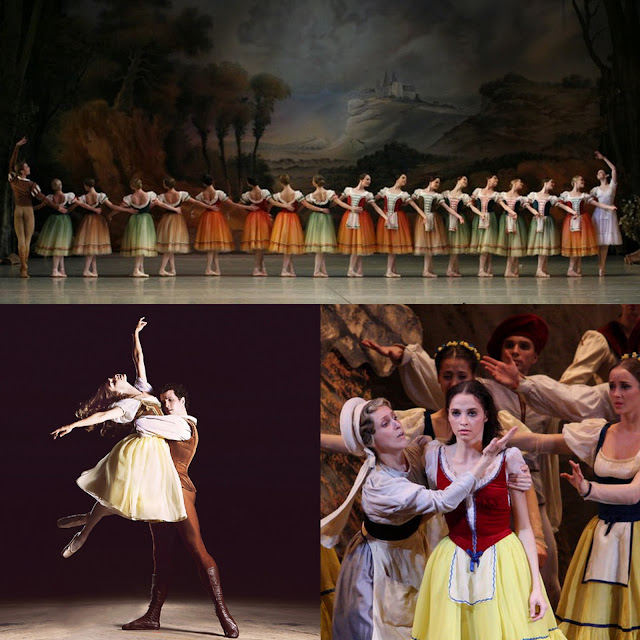A poor peasant girl falls in love with a man out of her league. It’s a story we’ve all heard before, a young girl who yearns for what she cannot have. Remember that feeling you had when you first fell in love….there’s a dance your heart does and Giselle’s heart was shining through her every delicate jeté.
“Giselle” is one of the most important and popular ballets in dance history. As a lover of French romanticism, it has always been my favorite. People go see romantic ballets like “Giselle” for the same reason we continue to see Shakespeare’s plays… the story is so good that we always discover something new that we hadn’t seen before. “Giselle” is still relevant today even though it was first performed in Paris in 1841.
My impressionable five-year old daughter had tears in her eyes watching “Giselle”; she was obviously moved by the ballet. When I asked her the next day what she thought of “Giselle” she said, “Oh Mommy, don’t make me think of Giselle, it breaks my heart!” Well, “Giselle” is a French ballet and the French do tend to have dark themes much like Disney…there’s always a dark side, a wicked queen, and a spooky forest…just enough to make a sensitive little girl emotional.
Going to see the Texas Ballet Theatre’s production of “Giselle” that Ben Stevenson (the artistic director) staged was a treat for all ages. The matinee was an audience full of little girls oohing and ahhing, especially when Giselle flew like Tinkerbelle across the stage. One child remarked, “Where’d she go?” “Giselle” was created during a time when ballet explored elevation and weightlessness. The ballerinas glide, float, and fly across the stage.
“Giselle” is a dark French tale of a young peasant girl who lives with her mother in a small village of the Rhineland in a medieval German town. A royal hunting party passes through Giselle’s village. A young village girl, Giselle has fallen obsessively in love with the royal Albrecht, an old-world duke who poses as a villager in order to steal her heart.
Hilarion, a real villager who also loves Giselle, becomes very jealous and plots to reveal Albrecht’s true identity. Albrecht declares his love to Giselle and promises to be faithful. Giselle playfully tests his promise with a daisy, plucking “he loves me, he loves me not” petals. She realizes with sadness that her last daisy petal shows Albrecht doesn’t love her. Albrecht patches up the daisy and Giselle is joyful again as they dance together. Hilarion arrives and tries to separate them and he is scolded by Giselle.
Giselle is unaware that Albrecht is engaged to the beautifully dressed Bathilde, daughter of a Duke. Bathilde is charmed by Giselle and presents her with one of her expensive necklaces from her neck. Giselle’s mother senses trouble and her daughter’s impulsive dancing reminds her of the ill-fated Wilis. Her mother is also worried about Giselle’s fragile and delicate heart.
When Giselle learns that Albrecht is betrothed to Bathilde, she takes off the necklace and loses her mind. Her hair tumbles down wildly and she puts her hands to her head and rocks back and forth. Going mad, Giselle stabs herself with Albrecht’s sword. Although Giselle takes her life with the sword, her death is actually a result of her weak heart.
After Giselle’s death, the second act takes the audience into a moonlit forest near the tomb where Giselle has been buried. A strange and supernatural forest is haunted by the Wilis, spirits of the betrothed girls who have died as a result of being betrayed by unfaithful loves. Each night they rise from their graves, waiting for young men that they will dance to death.
At the stroke of midnight the white veiled Wilis appear, led by their proud and ghostly Queen Myrtha. Hilarion has come to the tomb to grieve for Giselle. He is discovered by the Wilis and they drive him to the lake with a dance of exhaustion.
Myrtha summons Giselle from her grave to be welcomed into the sisterhood. Albrecht also comes to Giselle’s grave to mourn her. The eighteen Wilis form a beautiful white barrier of long diagonal lines and hop in arabesques as they crisscross the graveyard. Giselle is possessed with a forgiving love and begs for his release, Myrtha denies her request but lucky for Albrecht, he is saved by the bell once day breaks and the Wilis retreat to their graves. Giselle’s love has saved him and by not surrendering to feelings of hatred for Albrecht, Giselle is freed from any affiliation with the Wilis dark sorority, and returns to her grave to rest in peace.




